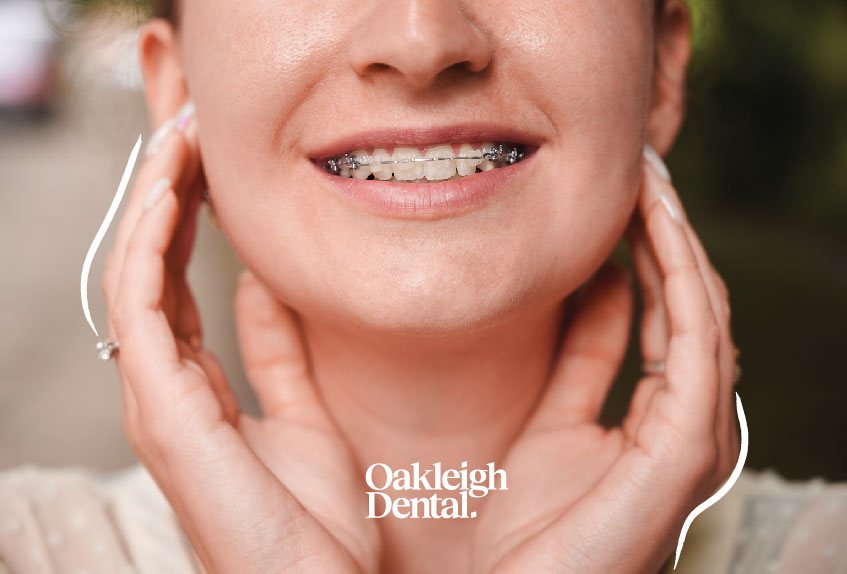The world of orthodontics has changed over the years, and the multitude of options available now give every new patient a lot of choice. One such option is Fast Braces, an orthodontic technology built around straightening your teeth quickly and with lasting impact. But what are they, and how do they compare to traditional orthodontics?
What are Fast Braces?
Fast Braces are an innovative orthodontic technology taking the concept of traditional braces and improving a variety of aspects. This updated version of braces is designed to move and straighten your teeth both quicker and more comfortably than traditional braces. Using different brackets, Fast Braces are best used to treat mild and moderate cases of teeth misalignment and malocclusion, with specific use cases including crowding, crooked teeth, overbites, underbites, and gapped teeth.

How do Fast Braces work?
The big difference in the Fast Braces technology is the use of triangular brackets instead of the usual square brackets that braces are known for. Triangular brackets are used to increase the size of the gap between each bracket, which in turn allows the braces to be joined by a single super-elastic wire. These pieces in combination enable there to be pressure on the teeth that is constant enough to move the teeth, but still more gentle and less painful than traditional braces.
Another main aspect of Fast Braces treatment is that they can move both the crown and the root of each tooth at the same time. Traditional braces can only do this through a two-step process, targeting each part of the teeth in a different phase, making your braces progress slower. The ability to complete both of these movements at once is part of the reason Fast Braces are so much quicker as a treatment course.
Differences
As a traditional braces alternative, Fast Braces are more gentle and lower in friction, leading to less soreness and sensitivity than their traditional counterparts. This is because traditional braces have larger brackets and less flexible wires, which can create some discomfort in the mouth, though it should not be major. Patients with traditional braces will also typically need to visit the dentist or orthodontist every 4 to 8 weeks for a readjustment to their wires, which extends the overall braces timeline. Where Fast Braces patients may only need 9 months for a full treatment course, traditional braces may take up to 2 years to be fully effective.
Another key difference is tooth extractions. To create enough room for teeth to adequately move around in the mouth, traditional braces patients will often need to have some of their teeth extracted prior to beginning treatment. By contrast, Fast Braces patients will typically not need to have any of their teeth extracted, thanks to the movement of the roots and crowns simultaneously.

Which should you choose?
There are a number of different signs that can indicate you need braces, including visibly crowded and crooked teeth, or teeth not closing properly when your mouth is at rest. Similarly, if you feel stress and chronic pain around your jawline, this can be a sign that your teeth and jaw are not in correct alignment.
In these cases, getting braces can help relieve discomfort and lead to a lasting improvement in your oral and dental health. However, knowing which type of braces to pick can be a challenge. Always consult with your dentist and they can help you understand which would be best for your unique case.
When to choose Fast Braces
Fast Braces are the best orthodontic option when you want an effective treatment that can be completed quickly, though it is important to note that they are not suited to every case. We recommend Fast Braces to patients who have mild to moderately severe cases of malocclusion and misalignment. This is because, though they still possess a lot of strength, Fast Braces are not quite as powerful as traditional braces. Using Fast Braces for very severe cases may not fully move your teeth to the correct positions or lead to lasting results.
When to choose traditional braces
Traditional braces may be your only option if you have a complex or severe case of misalignment. Though they will take longer, their added power will ensure that even the most complex cases will enjoy a lasting improvement (provided you follow your aftercare instructions). Similarly, if you suffer from severe jaw pain, including TMJ disorder, traditional braces will typically be recommended over Fast Braces.

How much do Fast Braces cost?
Fast Braces treatment is typically more affordable than traditional braces, due mostly to the efficiency of the treatment course. Additionally, patients will typically require fewer trips to the dentist or orthodontist for adjustments, saving some money compared to traditional treatment. However, your Fast Braces cost will vary depending on the severity and complexity of your case.
Overall, any orthodontic treatment will be a significant cost, and we understand that. However, compared to other orthodontic alternatives, Fast Braces are one of the more affordable choices that are still very effective in the right cases.
The quickest way to straighten teeth
Choosing between Fast Braces and traditional braces will depend on your individual needs and personal circumstances. Either way, we are here to support you and help you smile. Straighten teeth fast with treatment at Oakleigh Dental — book in for a consultation today.


